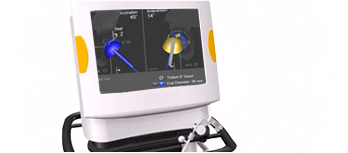Hip Arthroscopy

Introduction
Hip arthroscopy is key-hole surgery of the hip joint using a fibre-optic camera only 4.5mm in diameter. The camera is attached to a video monitor. Hip arthroscopy allows the surgeon to safely and accurately see inside the joint and perform procedures to correct problems that are found. Previously open techniques involving larger incisions and longer recovery periods had to be used. Although not all patients can be treated with arthroscopy, in many cases arthroscopy can be used instead of a bigger operation to achieve the same effect.
Hip arthroscopy is more difficult and complicated than knee arthroscopy because the hip joint is deeper below the skin than the knee joint.
Because the hip joint is a ball and socket joint the joint surfaces are closer together than in the knee and so a space between the ball and the socket has to be created by placing some gentle traction on the leg to pull the ball out of the socket.
Hip arthroscopy is performed under general anaesthetic ( asleep ) to ensure that the muscles around the hip are fully relaxed. Two to four small incisions ( usually about 5 - 10 mm each ) are used to introduce the camera and the instruments needed to perform the procedures required.
The procedure takes between 30 and 90 minutes depending on what is found and what interventions are required in the joint.
Indications
Hip arthroscopy is useful for accurate diagnosis of hip problems, as well as for planning further treatments.
As well as a being a diagnostic tool arthroscopy can be used for treatment: Patients with early damage to the hip joint often experience symptoms like pain or catching. Such symptoms can be greatly improved with hip arthroscopy. By using hip arthroscopy, it is also possible to correct some disorders of the hip joint ( like impingement and other types of dysplasia ). Left untreated such conditions may lead to the onset of hip osteoarthritis.
After the operation
Most patients have only mild discomfort when they wake up after a hip arthroscopy. There will be a dressing over the skin incisions (known as portals). Often the fluid used for irrigation during the procedure can leak out of the portals into the dressings after the operation and it is usual for the fluid to have a pink or red tinge. Small amounts of fluid may continue to drain for 24-36 hours. Most patients go home the morning following the day of surgery.
Patients are asked to take anti-inflammatory tablets for four weeks after surgery unless there is a reason not to.
For most patients there is no weight bearing restriction after the operation and you can put as much weight through the hip as is comfortable. Most patients use crutches for comfort for a short period ( a few days ).
It is advisable not to over-exert too early after the procedure as this cause more discomfort and swelling. You should gradually reintroduce and build up activities as your symptoms allow. You can drive a car as soon as you can do so without discomfort - usually within a few days. If your job is seated at a desk you can usually go back to work after two weeks.
People with more physical jobs may need 6 weeks off before returning. A slow return to sport can start often after 4-6 weeks. Some patients will still have some mild discomfort 3-4 months after the procedure. The degree of joint damage seen at arthroscopy is the most useful predictor of this.
Physiotherapy
Regular physiotherapy is essential during the recovery period to assist in rapid recovery of joint function and muscular control. If required, your local physiotherapist can obtain a copy of our recommended rehabilitation protocols by contacting the office. Hydrotherapy may be started after your wounds have been assessed at your first post-operative clinic review.Sample Hip Arthroscopy Rehabilitation Protocol
Phase I - Initial phase
Goal: Regain range of motion within tolerance, decrease pain and swelling, neutralise muscle atrophy
All exercises to remain within the pain-free range
Day of surgery
- Isometric gluteal sets
- Ankle pumps
- Heel slides
Post-operative days 1-7
- Weight bearing with crutches
- Isometric quadriceps, gluteals, hamstrings, adductors, and abductors
- Active assist range of motion all planes
- Hip mobilisation and gentle joint distraction techniques
- Closed chain bridging, balance drills
Phase II - Intermediate phase
Goal: Regain and build muscle strength, focus on symmetry/core strength
All exercises to remain within the pain-free range
To begin once fully weight bering and after range of movement is 85% of the uninvolved side
Post-operative weeks 2-3
- Wean crutches and normalise gait pattern
- Increase range of motion limits
- Gentle progressive resistive exercises
- Closed chain single leg bridging
- Open chain hip 4-way
- Mobilisation with movement
- Proprioceptive/balance work
- Stationary bike/aqua therapy
Phase III - Advanced phase
Goal: Improve functional strength and endurance, core strength & stability
To begin after full range of movement os achieved.
Post-operative weeks 4-6
- Continue flexibility exercises
- Progressively increase resistive and functional strengthening exercises
- Initiate sport specific exercises
- Gradual return to sport
Individual rehabilitation protocols will vary by patient and procedure, this information is simply a guide to the rehabilitation following hip arthroscopy in some patients. Always defer to your doctor when making decisions about your rehabilitation! Risks and Complications
Hip arthroscopy is a low risk procedure. Serious complications are rare and almost all resolve on their own with time.
Complications can be general or specific to hip arthroscopy:
General complications can occur after any operation and can include: Infection, allergic reactions to medications, blood loss requiring transfusion, Heart attacks, strokes, kidney failure, pneumonia, urine infections, complications from nerve blocks such as nerve damage or blood clots.
Blood clots can occur after any type of hip or knee surgery, usually in the calf muscles. The chance of this complication is higher in bigger operations such as Joint Replacement but may occur with the most minor of procedures, in fact they can occur without surgery at all. Occasionally they can cause serious problems and, rarely, even be life threatening.
Infections can occur in the skin at the portal sites or, more seriously, in the joint itself.
The most common adverse effect of hip arthroscopy is temporary discomfort, bruising or numbness around the foot or groin. This is related to the traction needed during the procedure and occurs in 2-8% of cases. Often it recovers within a few days but sometimes it can take longer to resolve.
Other complications and risks include, failure to improve symptoms in the hip or recurrence of symptoms. Heterotopic ossification (formation of abnormal bone within the muscles around the hip) is a rare complication and a course of anti-inflammatory tablets helps to prevent this.
Serious complications such as infection, bone fracture or permanent nerve injury are very rare.
Summary
Hip arthroscopy is an operation that is useful for diagnosis of hip conditions and for relieving symptoms. Although the risk of an adverse event is low, it is important that you are well informed about the operation and it’s risks before deciding to go ahead with surgery. The decision to proceed with surgery is made when the advantages outweigh the potential disadvantages.
|















